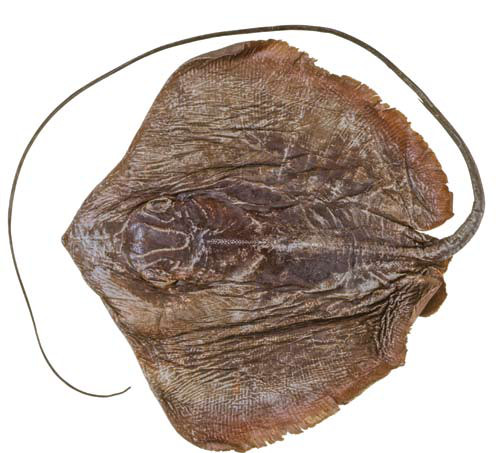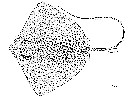Maculabatis toshi
(Whitley, 1939)
Black-spotted whipray
Classification: Elasmobranchii Myliobatiformes Dasyatidae
Reference of the original description
Taxonomic notes on sharks and rays. Australian Zoologist, 9(3), 227–262
Taxonomic notes on sharks and rays. Australian Zoologist, 9(3), 227–262
Synonyms / new combinations and misspellings
Himantura toshi
Himantura toshi
Description :
Citation: Maculabatis toshi (Whitley, 1939): In: Database of modern sharks, rays and chimaeras, www.shark-references.com, World Wide Web electronic publication, Version 12/2025
Please send your images of "Maculabatis toshi" to info@shark-references.com

Maculabatis toshi (Whitley, 1939), juvenile male holotype (AMS IA 39, 294 mm DW, preserved). In: Last, P.R. & Manjaji-Matsumoto, B.M. & Pogonoski, J.J. (2008): Himantura astra sp. nov, a new whipray (Myliobatoidei: Dasyatidae) from northern Australia. CSIRO Marine and Atmospheric Research Paper, 22: 303-314

Maculabatis toshi (Whitley, 1939), juvenile male holotype (AMS IA 39, 294 mm DW, preserved). In: Last, P.R. & Manjaji-Matsumoto, B.M. & Pogonoski, J.J. (2008): Himantura astra sp. nov, a new whipray (Myliobatoidei: Dasyatidae) from northern Australia. CSIRO Marine and Atmospheric Research Paper, 22: 303-314
Common names
 Black-spotted stingray,
Black-spotted stingray,  Black-spotted whip ray,
Black-spotted whip ray,  Black-spotted whipray,
Black-spotted whipray,  Blackspotted whipray,
Blackspotted whipray,  Coachwhip ray,
Coachwhip ray,  Ray,
Ray,  Toshs longtail ray,
Toshs longtail ray,  Wulura
Wulura
 Black-spotted stingray,
Black-spotted stingray,  Black-spotted whip ray,
Black-spotted whip ray,  Black-spotted whipray,
Black-spotted whipray,  Blackspotted whipray,
Blackspotted whipray,  Coachwhip ray,
Coachwhip ray,  Ray,
Ray,  Toshs longtail ray,
Toshs longtail ray,  Wulura
Wulura
Distribution
Indo-West Pacific: northern Australia and New Guinea, including the Arafura Sea and Timor Sea. Occurrence off Indonesia unknown. This species has been misidentified by most ichthyologists as a color form of Himantura uarnak [1388]. Source: www.gbif.org
Indo-West Pacific: northern Australia and New Guinea, including the Arafura Sea and Timor Sea. Occurrence off Indonesia unknown. This species has been misidentified by most ichthyologists as a color form of Himantura uarnak [1388]. Source: www.gbif.org
Human uses
fisheries: minor commercial; price category: low; price reliability: very questionable: based on ex-vessel price for species in this family
fisheries: minor commercial; price category: low; price reliability: very questionable: based on ex-vessel price for species in this family
Biology
Exhibit ovoviparity (aplacental viviparity), with embryos feeding initially on yolk, then receiving additional nourishment from the mother by indirect absorption of uterine fluid enriched with mucus, fat or protein through specialised structures [733]. Distinct pairing with embrace [17086]. Born at 20-22 cm WD [2539]. Found on the continental shelf (Ref. 9840, 75154). Juveniles (20-22 cm WD) are free swimming. Feed on prawns, small fishes and crustaceans (Ref. 9840).
Exhibit ovoviparity (aplacental viviparity), with embryos feeding initially on yolk, then receiving additional nourishment from the mother by indirect absorption of uterine fluid enriched with mucus, fat or protein through specialised structures [733]. Distinct pairing with embrace [17086]. Born at 20-22 cm WD [2539]. Found on the continental shelf (Ref. 9840, 75154). Juveniles (20-22 cm WD) are free swimming. Feed on prawns, small fishes and crustaceans (Ref. 9840).
Remarks
shark-references Species-ID=14654;
shark-references Species-ID=14654;
Parasites (arranged by Jürgen Pollerspöck)
Monogenea
Cestoda
Copepoda
Monogenea
- Heterocotyle whittingtoni Chisholm & Kritsky, 2020 [29076] [29167]
- Monocotyle caseyae Chisholm & Whittington, 2005 [29167]
- Thaumatocotyle australensis Beverley-Burton & Williams, 1989 [29167]
Cestoda
- Parachristianella baverstocki Beveridge, 1990 [16972]
- Parachristianella indonesiensis Palm, 2004 [16972]
- Parachristianella monomegacantha Kruse, 1959 [16252] [16112]
- Prochristianella aciculata Beveridge & Justine, 2010 [17404]
- Prochristianella clarkeae Beveridge, 1990 [16252] [16112] [17404]
- Rhinebothrium nickoli Coleman, Beveridge & Campbell, 2018 [26943]
- Scalithrium smitii Shinde, Deshmukh & Jadhav, 1981 [27352]
- Stillabothrium jeanfortiae Forti, Aprill & Reyda, 2016 [27352]
- Zygorhynchus elongatus Beveridge & Campbell, 1988 [16255] [16112]
Copepoda
- Caligus elasmobranchi Boxshall, 2018 [26229]

















